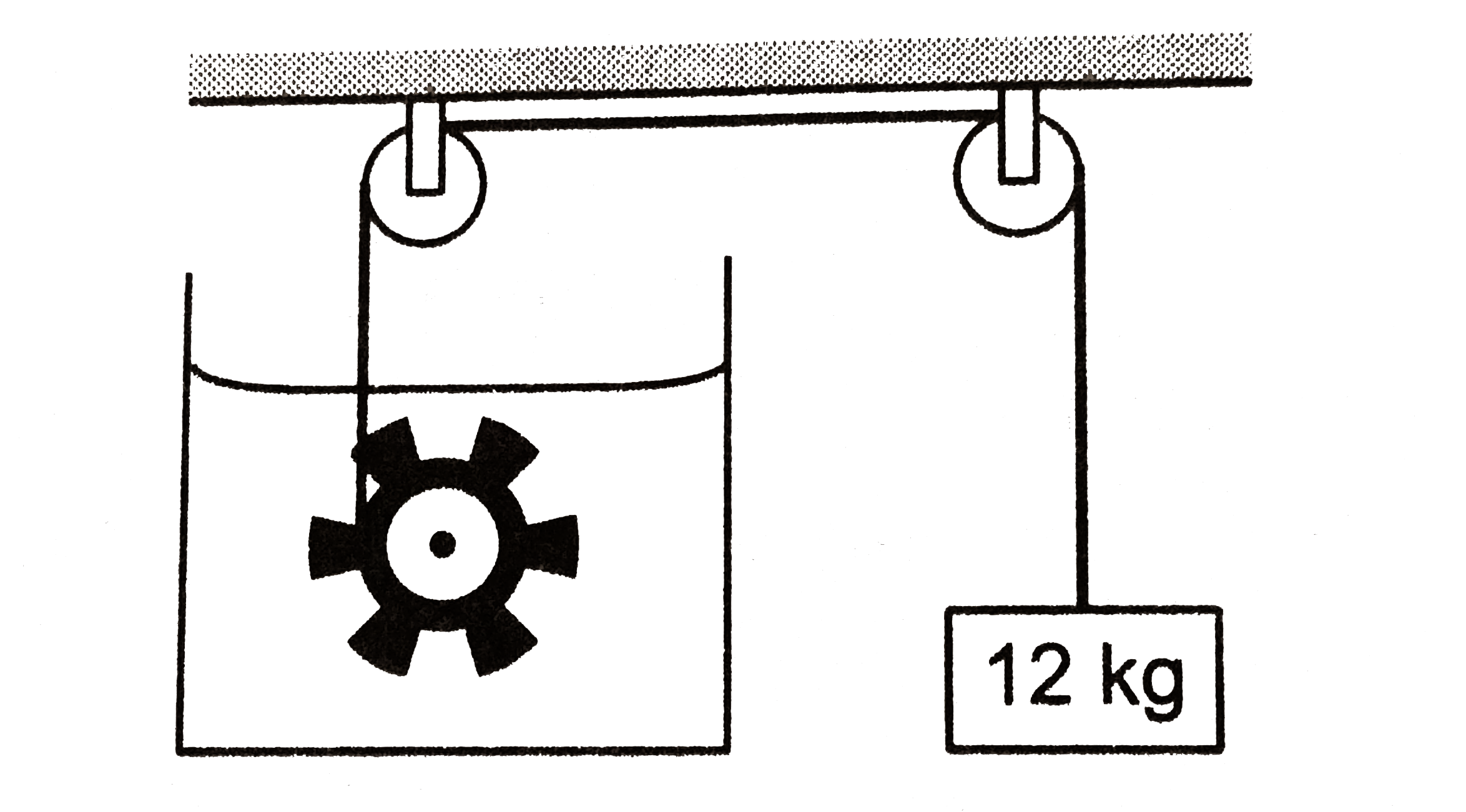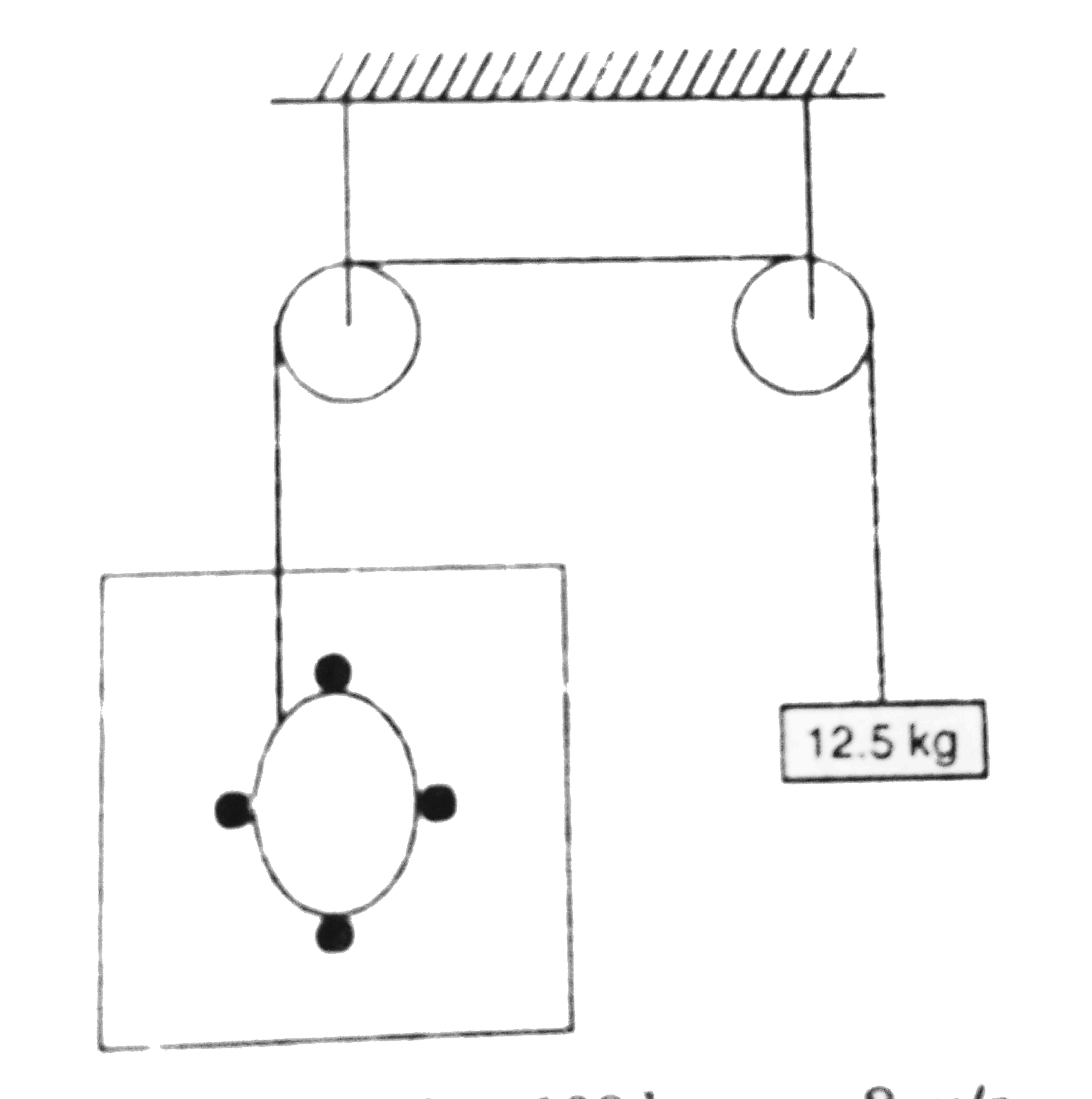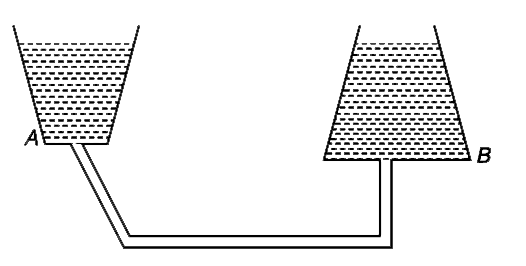Shows a peddle wheel couple to a mass of 12 kg through fixed frictionless pulley. The paddle is immersed in a liquid of heat capacity 4200JK−1 kept in an adiabatic container. Consider a time interval in which the 12 kg block falls slowly through 70cm. (a) how much heat is given to the liquid ? (b) how much work is done on the liquid? (c ) calculate the rise in the temperature of the liquid neglecting the heat capacity of the container and the paddle.
 Solution in Tamil
Solution in Tamil
The correct Answer is:A, B, C, D
(a) heat is not given to the liqiud Instead, the mechanical workdone is converted to heat.
So, heat given to liquid is zero
(b) Work done on the liquid is the PE lost by the 12 kg mass =mgh<br>=12x10x0*70ltbrge84 J
(c ) Let rise in temperature be Deltat We know, 84=msΔt,
⇒84=1×4200×Δt(form=1kg)
rArr Deltat=(84)/(4200)=(1)/(50)=0*02 k.

Topper's Solved these Questions
- BOOK - HC VERMACHAPTER - LAWS OF THERMODYNAMICSEXERCISE - Short Answer14videos
LAWS OF THERMODYNAMICS
- BOOK - HC VERMACHAPTER - LAWS OF THERMODYNAMICSEXERCISE - Objective II5videos
LAWS OF THERMODYNAMICS
- BOOK - HC VERMACHAPTER - KINETIC THEORY OF GASESEXERCISE - All Questions120videos
KINETIC THEORY OF GASES
- BOOK - HC VERMACHAPTER - NEWTON'S LAWS OF MOTIONEXERCISE - Exercises42videos
NEWTON'S LAWS OF MOTION
Similar Questions
Should the internal energy of a system necessarily increase if heat is added to it?
02:24View SolutionThe pressure p and volume V of an ideal gas both increase in a process.
04:55View SolutionCalculate the rms speed of nitrogen at STP (pressure =1 atm and temperature =00C. The density of nitrgoen in these conditions is 1.25kgm−3
View SolutionA block of mass 2 kg placed on a long frictionless horizontal table is pulled horizontally by a constant foerce F. It is found to move 10 m in the first two seconds. Find the magnitude of F.
02:16View SolutionA piece of ice of mass of 100g and at temperature 0∘C is put in 200g of water of 25∘ How much ice will melt as the temperature of the water reaches 0∘C? The specific heat capacity of water=4200Jkg−1K−1 and the latent heat of ice =3.36×105Jkg−1
02:09View SolutionA paddle wheel is connected with a block of mass 10kg as shown in figure. The wheel is completely immersed in liquid of heat capacity 400 J//K . The container is adiabatic. For the time interval in which block goes down 1m slowly calculate (a) Work done on the liuid (b) Heat supplied to the liquid (c ) Rise in the temperature of the liquid Neglect the heat capacity of the container and the paddle. (g = 10 m//s^(2))
02:59View SolutionContainers A and B contain a liquid up to same height. They are connected by a tube (see figure). (a) If the liquid in container A is heated, in which direction will the liquid flow through the tube. (b) If the liquid in the container B is heated in which direction will the liquid flow through the tube? Assume that the containers do not expand on heating.
 04:29View Solution
04:29View SolutionAn immersion type electric heater of 250 watts is immersed in 5kg of water contained in a bucket. In how much time will the temperature water rise by 10∘C? Sp heat capacity of water 1000calkg−1K−1 and J=4.1Jcal−1. Neglect heat capacity of bucket.
03:14View SolutionThe specific heat of water is 4180 J/kg°C. How much the heat capacity of 2 kg water ?
09:06View SolutionThe specific heat of aluminium is 900 J/kg°C. How much the heat capacity of 2 gram aluminium ?
View SolutionCalculate the heat required to convert 3 kg of ice at -12 ^(@) C kept in a calorimeter to steam at 100^(@) C at atmospheric pressure. Given specific heat capacity of ice = 2100 J kg^(-1) K^(-1) , specific heat capacity of water = 4186 J kg^(-1) K^(-1) , latent heat of fusion of ice = 3.35 xx 10^(5) J kg^(-1) and latent heat of steam = 2.256 xx 10^(8) J kg^(-1) .
04:09View SolutionCalculate the heat required to convert 3 kg of ice at −12∘C kept in a calorimeter to steam at 100∘C at atmospheric pressure. Given specific heat capacity of ice =2100Jkg−1K−1, specific heat capacity of water =4186Jkg−1K−1, latent heat of fusion of ice =3.35×105Jkg−1 and latent heat of steam =2.256×106Jkg−1.
04:29View SolutionCalculate the heat required to convert 3 kg of ice at −12∘C kept in a calorimeter to steam at 100∘C at atmospheric pressure. Given specific heat capacity of ice =2100Jkg−1K−1, specific heat capacity of water =4186Jkg−1K−1, latent heat of fusion of ice =3.35×105Jkg−1 and latent heat of steam =2.256×108Jkg−1.
View SolutionCalculate the heat required to convert 3 kg of ice at -12 ^(@) C kept in a calorimeter to steam at 100^(@) C at atmospheric pressure. Given specific heat capacity of ice = 2100 J kg^(-1) K^(-1) , specific heat capacity of water = 4186 J kg^(-1) K^(-1) , latent heat of fusion of ice = 3.35 xx 10^(5) J kg^(-1) and latent heat of steam = 2.256 xx 10^(8) J kg^(-1) .
04:32View SolutionA piece of ice of mass of 100g and at temperature 0∘C is put in 200g of water of 25∘ How much ice will melt as the temperature of the water reaches 0∘C? The specific heat capacity of water=4200Jkg−1K−1 and the latent heat of ice =3.36×105Jkg−1
04:27View SolutionCalculate the heat required to convert 3 kg of ice at −12∘C kept in a calorimeter to steam at 100∘C at atmospheric pressure. Given specific heat capacity of ice =2100Jkg−1K−1, specific heat capacity of water =4186Jkg−1K−1, latent heat of fusion of ice =3.35×105Jkg−1 and latent heat of steam =2.256×108Jkg−1.
02:35View Solution
